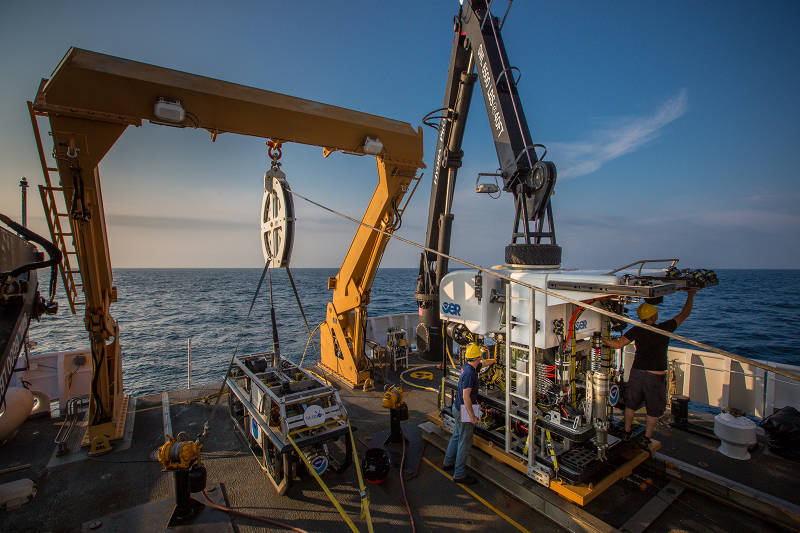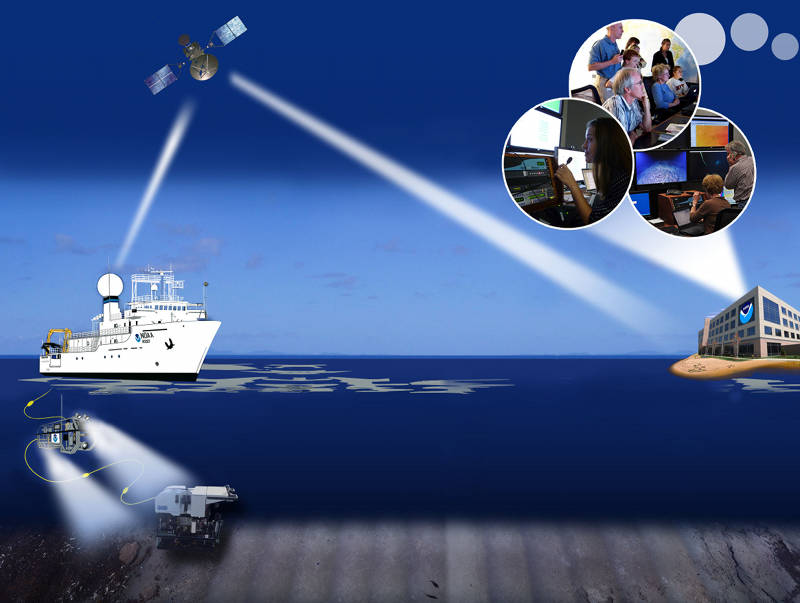
By Kelley Elliott - Expedition Manager, NOAA Office of Ocean Exploration and Research
Dr. Christopher Kelley - Science Team Lead, University of Hawaii
Brian Kennedy - Expedition Coordinator, NOAA Office of Ocean Exploration and Research

The project area to be explored: Papahānaumokuākea Marine National Monument and the Johnston Atoll Unit of the Pacific Remote Islands Marine National Monument, now known as Pacific Islands Heritage Marine National Monument. Image courtesy of the NOAA Office of Ocean Exploration and Research, created from a synthesis of existing multibeam mapping data by Dr. John R. Smith of the University of Hawaii. Download larger version (jpg, 5.6 MB).
From July 10 to September 30, 2015, NOAA Ship Okeanos Explorer will explore largely unknown deep-sea ecosystems in the Hawaiian Archipelago and offshore Johnston Atoll as part of the Hohonu Moana: Exploring the Deep Waters off Hawai’i expedition. During four separate cruise legs, NOAA and partners will investigate deep waters in and around Papahānaumokuākea Marine National Monument (PMNM) in the Northwestern Hawaiian Islands, Johnston Atoll in the Pacific Remote Islands Marine National Monument (PRIMNM), the Geologists Seamounts group, and the Main Hawaiian Islands.

The expedition marks the third field season using NOAA’s 6,000-meter remotely operated vehicle Deep Discoverer and the Seirios camera sled and lighting platform on NOAA Ship Okeanos Explorer. A pilot sampling program will be conducted during the July-to-September Hohonu Moana expedition to collect a limited number of geological and biological samples that are deemed to be of particular interest to expedition participants. All collected samples will be sent to an appropriate National repository for curation and on-site access. Image courtesy of the NOAA Office of Ocean Exploration and Research, 2015 Hohonu Moana. Download larger version (jpg, 1.7 MB).
Priority operating areas and science themes for this 69-day expedition were developed with input from scientists and managers across the broad ocean science community. Themes and objectives for the 2015 Expedition include:
Operations will use the ship’s deep-water mapping systems (Kongsberg EM302 multibeam sonar, EK60 split-beam fisheries sonar, and Knudsen 3260 chirp sub-bottom profiler sonar), NOAA’s two-body 6,000-meter remotely operated vehicle (ROV) system, CTD rosette, and a high-bandwidth satellite connection for real-time ship to shore communications.
ROV dives will include high-resolution visual surveys and limited sampling – including the first-ever look at deep seafloor habitats offshore of Johnston Atoll below 400 meters and habitats deeper than 2000 meters in PMNM.
The 69-day expedition is divided into four ‘legs’ – one 24-hours-a-day mapping leg followed by three combined ROV/CTD/mapping legs. The tentative schedule for the full expedition is:

NOAA Ship Okeanos Explorer uses telepresence technology to transmit data in real-time to a shore-based hub where the video is then transmitted to a number of Exploration Command Centers located around the country as well as to any Internet-enabled device. Access to the video combined with a suite of Internet-based collaboration tools allow scientists on shore to join the operation in real-time, and allows the general public to follow the expedition online. Image courtesy of the NOAA Office of Ocean Exploration and Research, 2015 Hohonu Moana. Download larger version (jpg, 1.2 MB).
The United States’ first and only federal vessel dedicated to exploration of our largely unknown ocean, NOAA Ship Okeanos Explorer conducts operations in a globally unique way, using telepresence to engage the majority of the science team from shore.
Via telepresence, live images from the seafloor and other science data will flow over satellite and high-speed Internet pathways to scientists around the country standing watches in Exploration Command Centers (ECCs), tuning in to the high-definition video using their institution’s Internet 2 connection, or watching the live video on commodity Internet. They will join an expedition teleconference and log into a centralized instant messaging server to contribute expertise and help guide the at-sea operation in real time, extending the reach of ocean exploration to more scientists and students than could ever be accommodated onboard.
A number of ECCs will be online for the expedition, including several ECCs joining Okeanos Explorer operations for the first time. ECCs online include: the University of Hawaii at Manoa; NOAA's Inuoye Regional Center in Hawaii; NOAA Headquarters in Maryland; Harbor Branch Oceanographic Institution in Florida; Inner Space Center at the University of Rhode Island; Stennis Space Center in Mississippi; University of New Hampshire; and Pacific Marine Environmental Laboratory in Washington.
Scientists are also expected to participate from a number of other remote locations, including Woods Hole, Massachusetts; Lafayette, Louisiana; Philadelphia, Pennsylvania; College Station, Texas; Orono, Maine; Corvallis, Oregon; Laramie, Wyoming; Moss Landing and San Diego, California; and Washington, DC. These scientists, and others on call if a discovery is made at sea, will add their expertise in real time to operations at sea.
This expedition provides extensive opportunities for the public to connect to the mission. The web pages for this expedition include background content; mission logs; daily updates; videos and images; near real-time ship tracking features; and a live video feed.
Educators and students can engage their classrooms through the Expedition Educational Module, which provides access to products tied to the expedition, including standards-based lesson plans, background information, ocean career connections, links to previous Office of Ocean Exploration and Research-sponsored expeditions, and more.